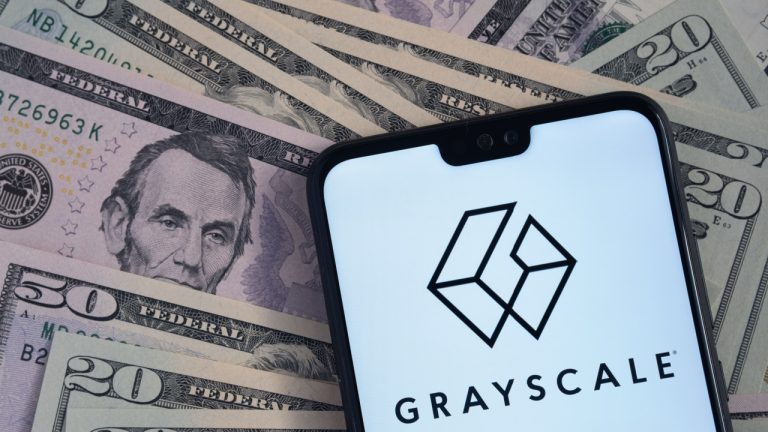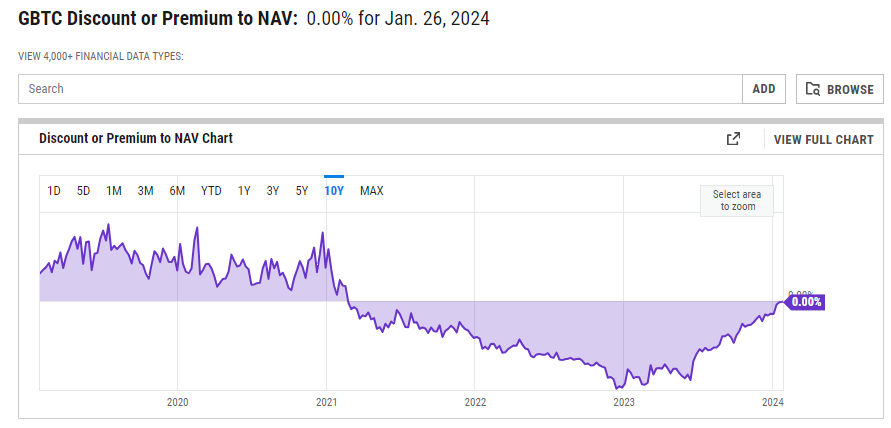
The recently disappeared GBTC discount may be “a sign of industry maturing and the improved enterprise acceptance of bitcoin.” While some see the disappearance of the discount as pointing to the re-emergence of the premium to the net asset value (NAV), one expert said he sees “the continued parity or even a resurgence of the discount” as real possibilities.
The Impact of Spot Bitcoin ETF Approvals
On or around January 26, the discount to the net asset value (NAV) of the Grayscale Bitcoin Trust (GBTC) narrowed to zero for the first time in nearly three years. Since descending to 44% in June 2023, the discount has gradually shrunk and by Dec. 20, 2023, it had reached the single-digit figure of 7%.

According to Ycharts data, the last time the discount to the NAV was around zero was sometime around February 21, 2021. The gradual disappearance of the GBTC’s discount to NAV has been attributed to many factors including the spot bitcoin exchange-traded funds (ETF) approval speculation that gripped the crypto market for much of the second half of 2023.
Meanwhile, the disappearance of the discount has prompted some to predict the imminent return of the premium to the NAV. Others, however, have warned that this return to a premium is not a given because crypto assets like bitcoin are still volatile. They argue that the approval of spot bitcoin exchange-traded funds (ETF) alone will not change that.
Nevertheless, some experts, such as Mant Hawkins, the Core Contributor at Andromeda, see the disappearance of the discount as a sign of how far the crypto industry has matured. He cites the U.S. Securities and Exchange Commission (SEC)’s recent approval of spot bitcoin ETFs as proof of the extent to which cryptocurrencies like Bitcoin (BTC) are being adopted.
“I see the narrowing of the discount as a sign of the industry maturing and the improved enterprise acceptance of BTC. The BTC ETF approval decision, as welcome as it was, seems to be just one more slow turn of the adoption wheel,” Hawkins said.
The Return of the GBTC Premium
Another expert, Denis Petrovcic, co-founder and CEO of Blocksquare, said he does not rule out the market reacting to the disappearance of the discount by “pushing it to a premium we have not seen since 2020.” However, Petrovcic also concurred that crypto assets like BTC remain volatile, and not even the ETF hype can change this.
If indeed the GBTC’s premium is to return, Petrovcic said he foresees this ultimately gravitating to back NAV “to compensate for the ETF’s convenience and accessibility.”
Meanwhile, Zak Taher, the CEO of Multibank.io, indicated that he agrees with many of his peers’ views on what the disappearance of the discount likely means. However, Taher also told Bitcoin.com News that while a premium is a possibility, the “continued parity or even a resurgence of the discount are also potential scenarios.”
Andrey Stoychev, head of Prime Brokerage at Nexo explained that from an economic standpoint, one might suggest that the market has achieved a balance between the supply of and demand for GBTC shares. Hypothetically speaking, Stoychev said if inflows and outflows are equal, the present bitcoin price offers the most significant chance for profit realization in the past two years.
“With spot bitcoin ETFs approved, Grayscale investors have now been simply freed to realize gains,” Stoychev told Bitcoin.com News. “Fortunately, that selling pressure has been absorbed by newer market participants and investors, as evident from the disappearance of the GBTC discount. Predicting a meaningful premium is tricky; it depends on Bitcoin demand and industry-wide events, like the upcoming block rewards halving, that could shift supply dynamics and impact the GBTC discount.”
Stoychev added:
Arguably, right now, investors are spoiled for choice on how to gain exposure to Bitcoin. That field, dominated by the world’s leading asset managers, will possibly be characterized by miniscule margins and fierce price competition. Should this be the case, serious deviations toward a premium or discount for GBTC shares are unlikely without a significant, industry-wide event to disturb the markets and force investors into fear or greed.
Before dropping to zero in late February 2021, the digital asset investment product’s premium to NAV ratio had largely stayed above 10%. After the premium turned negative, the price of the GBTC stock also began to drop.
As shown by the data, the price of GBTC fell from one of its 2021 highs of just over $51 to less than $9 in December 2022. However, since then, the price has rallied. At the time of writing, one GBTC share was trading at just above $37. As of Jan. 30, 2023, GBTC’s BTC reserves are now under 500,000 at 496,573.81 BTC.
What are your thoughts on this story? Let us know what you think in the comments section below.








